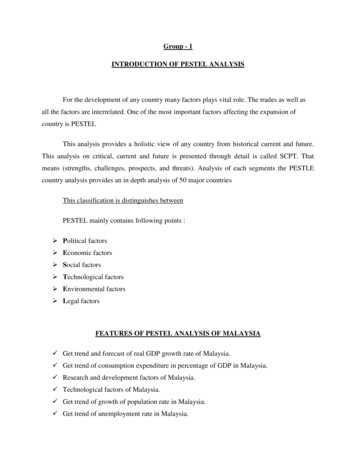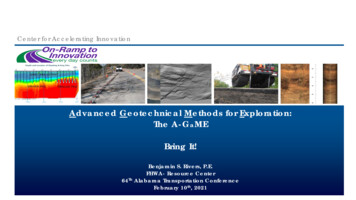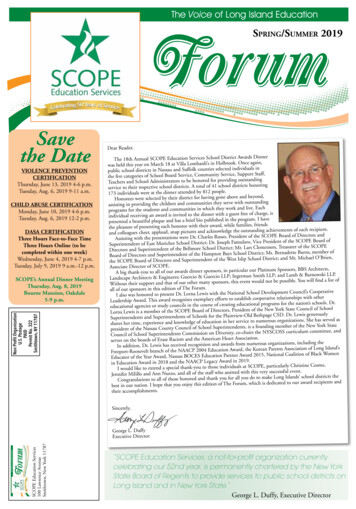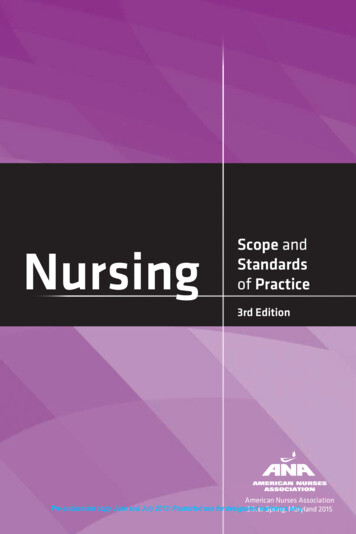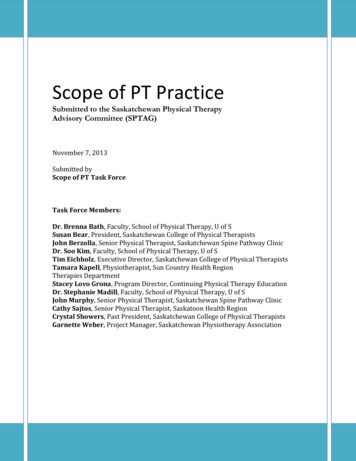
Transcription
Scope of PT PracticeSubmitted to the Saskatchewan Physical TherapyAdvisory Committee (SPTAG)November 7, 2013Submitted byScope of PT Task ForceTask Force Members:Dr. Brenna Bath, Faculty, School of Physical Therapy, U of SSusan Bear, President, Saskatchewan College of Physical TherapistsJohn Berzolla, Senior Physical Therapist, Saskatchewan Spine Pathway ClinicDr. Soo Kim, Faculty, School of Physical Therapy, U of STim Eichholz, Executive Director, Saskatchewan College of Physical TherapistsTamara Kapell, Physiotherapist, Sun Country Health RegionTherapies DepartmentStacey Lovo Grona, Program Director, Continuing Physical Therapy EducationDr. Stephanie Madill, Faculty, School of Physical Therapy, U of SJohn Murphy, Senior Physical Therapist, Saskatchewan Spine Pathway ClinicCathy Sajtos, Senior Physical Therapist, Saskatoon Health RegionCrystal Showers, Past President, Saskatchewan College of Physical TherapistsGarnette Weber, Project Manager, Saskatchewan Physiotherapy Association
Table of ContentsEXECUTIVE SUMMARY . 2INTRODUCTION . 3BACKGROUND . 3Physical Therapy Practice.3Scope of Practice .4PT Scope of Practice in Canada and Saskatchewan .5Evolving Scope of Practice .6Advanced Practice/ Extended Scope in Physical Therapy Practice .6SASKATCHEWAN POPULATION HEALTH AND HEALTH CARE CONSIDERATIONS . 7CURRENT “ADVANCED PRACTICE” ROLES IN SASKATCHEWAN . 9POTENTIAL AREAS TO CONSIDER FOR ADVANCED PRACTICE IN SASKATCHEWAN . 10Musculoskeletal. 10Neurology and Physiatry . 11Cardiorespiratory . 12PRAGMATIC CONSIDERATIONS: . 13RECOMMENDATIONS: . 15CONCLUSION: . 16APPENDICES . 17APPENDIX A: Scope of Practice Task Force - Terms of Reference . 17APPENDIX B: Essential Competency Profile for Physiotherapists in Canada . 19APPENDIX C: Access to Physiotherapy Services – Focus: Low Income Residents ofSaskatchewan. 20APPENDIX D: Overview of the Saskatchewan Hip and Knee Surgical Pathway, SpinePathway and Pelvic Floor Pathway. 31APPENDIX E: Current Saskatchewan Physical Therapy Scope of Practice . 35APPENDIX F: Summary of Areas Where PTs Contribute Within Traditional Roles andPossible Areas to Explore Extended Scope . 37APPENDIX G: Stakeholder Review . 41APPENDIX H: Ontario and Alberta Scope of Practice . 50APPENDIX I: Current Scope of Practice for Physical Therapists in Saskatchewan 2012 . 53Scope of PT Task Force1
EXECUTIVE SUMMARYRecent advances in Physical Therapy research, education and practice coupled withincreasing costs and demands on the health care system have led to Physical Therapists(PTs) assuming new emerging roles in Saskatchewan and elsewhere in Canada. Examples ofthese roles may include ordering of diagnostic tests or triaging patients referred medicalspecialists.A Physical Therapy Scope of Practice Task Force, convened by the Saskatchewan PhysicalTherapy Advisory Group (SPTAG)1, examined issues related to physical therapy (PT) scopeof practice in Saskatchewan and developed a summary report of its findings,recommendations, and considerations provided in a Saskatchewan-specific context.Saskatchewan is facing many demographic trends such as: an aging population, a largeproportion of the population living in rural and remote regions, and a high proportion ofAboriginal people. The Government of Saskatchewan is currently in the process ofimplementing a number of initiatives to re-design health care delivery models, making itimportant to consider the delivery and funding of, along with access to PT services in theprovince and whether development of advanced practice roles would be beneficial in theSaskatchewan context to deliver patient-centered care in a more optimized manner.The Scope of Practice Task Force identified several practice settings where PTs are currentlyengaged in non-traditional and/or “advanced practice” roles in Saskatchewan. The TaskForce interviewed physiotherapists and stakeholders in Saskatchewan to determine theservices that they felt physiotherapists could provide within the current scope of practice inSaskatchewan and areas to explore for the potential for extended scope. The task forcedetermined that advanced practice roles could be established in many different practice areasin Saskatchewan.Role optimization or the development of advanced practice roles in some areas (e.g. neurorehabilitation and physiatry) has the potential to contribute to addressing challengesassociated with recruitment of other health practitioners to Saskatchewan and access toneeded care. The treatment of musculoskeletal disorders is a common practice area in whichphysiotherapists in Saskatchewan and other jurisdictions are involved in new and emerging1The Physical Therapy Advisory Group (SPTAG) has membership from the School ofPhysical Therapy, the Saskatchewan College of Physical Therapists (licensing body), theSaskatchewan Physiotherapy Association (professional association), and ContinuingPhysical Therapy Education (organization that provides post graduate continuingeducation).Scope of PT Task Force2
roles. The Scope of Practice Task Force provided examples of expanded or optimized PTscope to consider in Saskatchewan in a variety of practice settings that have the potential toadd value and efficiencies to patient care based on input received from stakeholders.The Task Force also identified several pragmatic considerations to be addressed beforeexpansion of the scope of practice of physiotherapists in Saskatchewan is undertaken. Theseinclude: consideration of the needs of the community and the health care system; the fit ofthe new roles with the local and regional practice context; regulatory requirements; thereceptivity of the public and other stakeholders to these new roles; the sustainability of thenew roles; and the potential costs of the expanded roles to physiotherapists, other healthcare professionals, funding sources, and the health care system.The Scope of Practice Task Force recommends that extended scope of practice and/ or roleoptimization for physiotherapy be considered in Saskatchewan. Recommendations for nextsteps include: consultation with other jurisdictions that have implemented AdvancedPractice PT roles and education programs; conducting in depth key stakeholder analysis forspecific advanced practice roles that would add value; developing information regarding theanticipated financial costs and timeframes; as well as the development of practice models inwhich a variety of patient, provider, and system level impacts and outcomes are evaluated.Finally, a review of the current PT entry to practice competencies and potential developmentof post-professional education requirements for expanded roles should be undertaken priorto widespread implementation of advanced practice roles.INTRODUCTIONPhysiotherapists (PTs) are important members of the health care team providing high qualitycare to Saskatchewan residents. The development and growth of physical therapy (PT)research, education and practice over the past years, together with the current demands onthe health care system, including problems accessing appropriate health care, have led to PTsassuming new emerging roles in Saskatchewan and elsewhere in Canada2.In 2011, the Saskatchewan Physical Therapy Advisory Group (SPTAG) recommended that atask force be established to examine issues related to scope of PT practice in Saskatchewan. 3The purpose of the task force was to examine issues related to scope of practice in theprovince and to make recommendations that would “enable Physical Therapists to practicewithin the full available scope of PT practice as well as have opportunities to work inadvanced scope of practice roles in Saskatchewan.” The following document provides asummary of the task force’s findings, recommendations, and considerations taking intoaccount a Saskatchewan-specific context whenever possible.BACKGROUNDPhysical Therapy PracticePhysical therapists are uniquely qualified to assess, improve and maintain functionalindependence and physical performance and to prevent or manage pain, physical2CPA Practice Research Department. Scope of Practice Briefing Note. July 2012.Appendix A - Scope of Practice Task Force Terms of Reference.Scope of PT Task Force33
impairments, disabilities and limitations to participation in life activities. PTs areautonomous, self-regulated health professionals with the necessary university education andexperience to address the needs of health promotion and disease prevention, both on anindividual basis as well as at the community level.Scope of PracticeAlthough the term “scope of practice” is used frequently in health professional documents,there is no consistent definition4. The meaning of scope of practice varies among and withinhealthcare professions 5 . The majority of definitions outline activities or roles one isauthorized to perform, but how this authority is given (i.e. education, legislation,competencies, and employer) varies across definitions.Scope of practice can be identified by the following three categories6:1. Education and training — Has the person been educated academically or on-the-joband have documentation proving education to do the item in question?2. Governing body — Does the state, district, province or federal government thatoversees the skill or profession allow (or not explicitly disallow) the item in question?3. Institution — Does the institution allow a person or their profession to do the itemin question?The key features of scope of practice outlined above are mirrored in the definition putforward by Canada’s National Physiotherapy Advisory Group7:“ a profession’s scope of practice encompasses the services its practitioners areeducated, competent and authorized to provide. The overall scope of practice for theprofession sets the outer limits of practice for all practitioners. The actual scope ofpractice of individual practitioners is influenced by their continuing professionaleducation, the settings in which they practice, the requirements of the workplace, andthe needs of their patients or clients8.”4Baranek PM. A review of scopes of practice of health professions in Canada: A balancingact. 2005.5White D, Oelke, N.D., Besner, J., Doran, D., McGillis Hall, L., & Giovannetti, P. Nursingscope of practice: Descriptions and challenges. Nursing Leadership. 2008;21(1):44-57.6Sherwood GDB, M.B.; Fay, V.; Wardell, D. Defining Nurse Practitioner Scope of Practice:Expanding Primary Care Services. The Internet Journal of Advanced Nursing Practice.1997;1(20).7National Physiotherapy Advisory Group. Essential Competency for Profile forPhysiotherapists in Canada. 2009. The National Physiotherapy Advisory Group iscomprised of: the Canadian Alliance of Physiotherapy Regulators (The Alliance), CanadianPhysiotherapy Association (CPA) & Canadian University Physical Therapy AcademicCouncil (CUPAC)Scope of PT Task Force4
Even though scope of practice is typically defined as boundaries of a profession, it is alsoaffected by the competency, skill, and personal philosophies of the individual professional.As such, professional scope is determined by legislation and standards whilst individualscope is determined by organizational policy, culture, individual competence, knowledge andskill8,9. It is also important to note that scope of practice is seen as a fluid concept thatevolves as knowledge, technology, and the health care environment change10.PT Scope of Practice in Canada and SaskatchewanThe scope of physical therapy (PT) practice in Saskatchewan is not clearly defined withinprovincial legislation; only the title “Physical Therapist’ or “Physiotherapist” is protected bylegislation. In the absence of a clearly defined scope of PT practice, regulators, health careproviders, employers and other professional organizations must rely instead on the“standards of practice” of the profession. “Standards of practice” is an umbrella term for keydocuments describing values, priorities and practice of a profession necessary for safepractice including: professional standards, ethical guidelines, entry-level competencies,provincial regulations, standards of care, and practice guidelines. Standards representperformance criteria and can help interpret a scope of practice5. Standards of practice are aset of expectations that reflect a general agreement on competent practice which may beformally documented and approved or comprise usual and customary practice8.A key foundational document that can help to delineate the standards of practice of PhysicalTherapists is the Essential Competency Profile (ECP) for Physiotherapists in Canadadeveloped by the National Physiotherapy Advisory Group11. The ECP describes the essentialcompetencies (i.e. knowledge, skills and attributes) required by physiotherapists both at thebeginning of and throughout their career. It provides guidance for PTs to build on theircompetencies over time. The ECP is meant to reflect the diversity of PT practice and to helpsupport evolution of the profession in relation to the changing nature of practiceenvironments and advances in evidence-informed practice8.As previously noted the “scope” of PT practice is broad and open to interpretation based onguiding professional standards of practice and/ or individual variations in scope related toorganizational and practice context and culture, as well as individual competence, knowledge,and skill level. A broader definition of scope of practice allows for innovative responses tothe evolving nature of health care and health professional practice. This means that PTsshould not necessarily be restricted by the statutory definition of their scope of practice (ifindeed there is one), but rather that they use their knowledge and skills in safe, effectivedelivery of services in their profession.8International Centre for Allied Health Evidence. Tools to assist in the implementation ofextended scope of practice allied health roles started pack. 2009.9Schuiling KDS, J. Scope of practice: Freedom within limits. Journal of Midwifery andWomen’s Health. 2000;45(6):465-71.10Visocan BS, J. Understanding and using the scope of dietetics practice framework: A stepwise approach. Journal of the American Dietetic Association. 2006;106(3):459-63.11Appendix B - The 2009 version of the Essential Competency Profile developed by theNational Physiotherapy Advisory Group.Scope of PT Task Force5
Evolving Scope of PracticeAmong many practice contexts and individual health care providers, the de facto scope ofpractice (however that is determined), has not kept pace with the competencies that manyhealth care providers have acquired through their entry to practice training, practiceexperience, and continuing professional education. The development and growth of PTresearch, education and practice over the past several years together with the currentdemands on the health care system, including problems accessing appropriate health care,have led to PTs assuming new emerging roles in Saskatchewan and elsewhere in Canada.Without this type of ongoing evolution, significant important PT practice changes inSaskatchewan, such as the implementation of “direct access” in the 1990’s, would not havetaken place12.This evolution of practice roles can be viewed as a continuum ranging from well within“scope” of traditional PT practice boundaries, maximized/ optimized or expanded scope,advanced practice and extended scope. At one end of the spectrum are PTs who practicewell within traditional roles historically performed by PT’s, whose practice may notnecessarily reflect the whole range of education, training and experience that they haveaccrued or possibly have not evolved or “advanced” their practice to reflect current bestevidence or practice guidelines. At the other end of the spectrum are PTs working in“extended scope” roles whose practice, roles, and tasks are more clearly outside theboundaries of traditional PT practice.Advanced Practice/ Extended Scope in Physical Therapy PracticeThere is little agreement across Canada or internationally as to how best to define “advancedpractice” or “extended scope” PT roles. A recent publication from Australia defines“advanced practice” as the application of clinical skills, reasoning, knowledge and experiencein areas of practice previously performed by other professions or in new clinical areas13. PTroles within the United Kingdom health care system have evolved considerably, includingthe development of extended scope roles. In 2008 there was a fundamental shift in thedefinition of scope of PT practice in the UK as follows: “any activity undertaken by anindividual physiotherapist that may be situated within the four pillars of physiotherapypractice where the individual is educated, trained and competent to perform that activity.Such activities should be linked to existing or emerging occupational and/or practiceframeworks acknowledged by the profession, and be supported by a body of evidence”14.This has resulted in tasks previously considered “extended scope” now being classified as“advanced practice”17.12Direct access allows for PTs to be first contact primary care providers whereby people canseek and receive care from a PT without a referral from a physician13Crane J, Delany, C. Physiotherapists in emergency departments: responsibilities,accountability and education. Physiotherapy. 2013;99:95-100.Scope of PT Task Force6
Extended scope of practice, also known as advanced practice in Canada 15, can be defined asemployment contexts where a physical therapist (PT) may perform activities which areconsidered to be outside the traditional scope of entry-level PT practice16. Currently twopaths exist to perform advanced practice activities. The first is to participate in additionalpost-graduate training to become certified to perform specialized physical therapyprocedures, such as acupuncture or pelvic floor examination and treatment. The other pathoccurs when the advanced practice activity is not clearly addressed in the professionalregulatory guidelines. The core competencies and skill sets of PT combined with additionalinter-professional training and experiences have provided opportunities for PTs working in“advanced practice” roles to perform additional controlled acts (usually under medicaldirectives or delegation)17. PTs working in advanced practice or extended scope roles haveprimarily been set up on a case-by-case basis at the institutional level (e.g. place ofemployment). However, more recently, scope of PT practice legislation has been expandedin some jurisdictions in Canada through partnerships among professional associations andthe regulatory bodies. For example, physiotherapists in Ontario who intend to performadditional authorized activities may have their names added to a roster associated with theactivity they plan to perform. Each of the authorized activities has its own list or roster.SASKATCHEWAN POPULATION HEALTH AND HEALTH CARE CONSIDERATIONSFrom a population health perspective, many of the health issues facing Saskatchewancommunities are strongly associated with demographic trends such as: an aging population, alarge proportion of the population living in rural and remote regions, and a high proportionof Aboriginal people. Further to these demographic trends, the organization and delivery ofhealth care services are in constant flux.The Government of Saskatchewan has recently undertaken many initiatives to reorganizehow health care is delivered. The goal of these initiatives is ultimately to “explore newapproaches that cut unnecessary red tape, streamline processes and result in a safer, moreefficient, patient- and family-centered health system”18. Included among these innovations15Although there is no universally accepted definition of “advanced practice”, we arereferring to practitioners with advanced clinical expertise who work beyond the traditionalboundaries of PT scope of practice. Advanced practice PTs may or may not haveundertaken postgraduate interprofessional education and training to acquire these additionalskills and competencies. Note that advanced practice PT and extended scope practitioner areoften used interchangeably.16CPA Practice and Research Department. Scope of practice briefing note. 2010 July.17Refers to conferring authority from a regulated health professional authorized to performa controlled act or procedure under a health profession act to someone who is notauthorized to perform the procedure. A “direct order” is patient specific and a “medicaldirective” is a written and/or institutional policy.18“Innovations in Health Care” Government of ns. (accessed March 18th, 2013)Scope of PT Task Force7
are: the Saskatchewan Surgical Initiative19; Primary Health Care re-design20; the application ofLEAN principles to health services21, and Improving Emergency Waits and Patient Flow22.The underlying principles of these innovations are guided by the findings of the Patient FirstReview23 and have been incorporated into the strategic plans and targets of the SaskatchewanHealth Ministry24. The Saskatchewan government has stated a target to eliminate EmergencyDepartment wait times by 2017 (Saskatchewan Plan for Growth, 2013). Adding PT services(with or without extended scope) to the interdisciplinary teams within EmergencyDepartments is associated with higher levels of patient satisfaction for patients with softtissue injuries and equivalent levels of services provision as compared with other health careprofessionals25 26.Amidst the revamping of the publically funded health care system, it is important to considerthe delivery and funding of, and access to, PT services in the province. Saskatchewan had611 licensed PTs in 2011. This translates to 57.4 PTs per 100,000 population, compared tothe Canadian average of 51.1 (range 42-97) PTs per 100,00027. A slight majority of PTs(59%; 322) work in the public sector compared to 41% (224) that work in the private sector.PT services outside of health region facilities are not universally covered throughSaskatchewan Health, so the ability to pay for services and/or access to additional healthinsurance can be an important factor in accessing PT care. The services and availability ofPT services varies significantly across the regions in Saskatchewan with many public facilitiesfacing waiting lists and a need to prioritize acute care needs28. Furthermore, the vast majority19The Surgical Initiative has a dual mission to improve surgical patients' care experience andensure that no one in the province has to wait longer than 3 months for surgery by ve20A vision for strengthening primary health care in the province is outlined in the report: Aframework for achieving a high performing health care system in Saskatchewan (2012). TheFramework is described as “ the road map for a patient-centered primary health care systemthat will ensure timely access to appropriate care ”. (p. 4) Team-based interprofessionalcare is emphasized throughout the document as being an essential aspect of effective PHCmodels. ean is a “patient-first approach that puts the needs and values of patients and families atthe forefront and uses proven methods to continuously improve the health ellan, Greenwood and Benger. Effect of an extended scope physiotherapy serviceon patient satisfaction and the outcome of soft tissue injuries in an adult emergencydepartment. Emergency Medicine Journal. 2006 May, 23(5):384-387.26 Middleton McClellan, Cramp, Powell and Benger. A randomized trial comparing theclinical effectiveness of different emergency department healthcare professionals in softtissue injury management. BMJ 2012; 2(6).27CIHI. Physiotherapists in Canada 2011, Spending and Health Workforce. Ottawa, ON:Canadian Institute for Health Information, 2012.28Appendix C – Access to PT for Low Income Residents of Saskatchewan, SPA September2013.Scope of PT Task Force8
(83.1%) of PT employed in Saskatchewan are located in urban areas, while approximatelyone third of Saskatchewan residents live in rural areas29 ; resulting in limited access to PTservices in many rural and remote regions of the province.CURRENT “ADVANCED PRACTICE” ROLES IN SASKATCHEWANThrough consultation with its members and other key stakeholders, the Scope of PracticeTask Force has identified five practice settings where PTs are currently engaged in nontraditional, optimized and/or “advanced practice” roles in the province. Four are funded bySaskatchewan Health and form part of the surgical pathways (e.g. hip and knee, spinal, pelvicfloor and prostate cancer pathways)30 and one is a spinal triage program within the privatesector. The hip and knee, and spinal pathways, and the spinal triage program involve PTsperforming primarily a “triage” role within inter-professional collaborative care models;patients are first screened by a PT to determine if referral to a surgeon or recommendationfor further conservative management and/or diagnostic investigations is appropriate. Theability to order diagnostic imaging is an emerging advanced practice role elsewhere inCanada. For example, currently legislation allowing PTs the act of ordering x-rays is availableto 55% of PTs in Canada and ordering of MRIs is available to 41% of PTs in Canada.Recommendations for diagnostic tests may be initiated by the PTs, but through a directiveapproach, are ultimately ordered by the surgeons. The purpose of the triage model of interprofessional care is to improve patient through-put in busy healthcare settings, and to allowpatients to access the appropriate management for their problem in a more timely fashionthan waiting to see a physician/ surgeon first31. The other two pathways (pelvic floor andprostate cancer) have physiotherapists working in roles that require advanced certificationand corresponding regulatory rostering (See Appendix D for details).Since approximately 1996, PTs in Saskatchewan have taken on an expanded role in thirdparty payer (e.g. WCB, SGI, other third party payers) multidisciplinary assessment andtreatment models. The model developed in Saskatchewan represents an evolution or“advancement” of PT scope practice and is fairly unique to this province. This role includescase management (e.g. PTs as first point of contact for communicating with other healthcare providers, co-ordination of return to work planning), participation in (and in themajority of cases in the province, leading) multidisciplinary assessment teams andcomprehensive management plans (e.g. education, regional and functional conditioning,manual treatment, psychological assessment and treatment), and serving as consultants tomake recommendations regarding the adjudication of challenging cases.29Approximately one third of Saskatchewan residents lived in rural areas. Statistics 01/t002-eng.htm.30Appendix D – Overview of the Hip and Knee Surgical Pathway, Spine Pathway and PelvicFloor Pathway.31Aiken AB, McColl M. Interprofessional Healthcare: A common taxonomy to assist withunderstanding. J Allied Health. 2009;38:92-6.Scope of P
APPENDIX I: Current Scope of Practice for Physical Therapists in Saskatchewan 2012 .53 . Scope of PT Task Force 2 EXECUTIVE SUMMARY Recent advances in Physical Therapy research, education and practice coupled with increasing costs and demands on the health care system have led to Physical Therapists (PTs) assuming new emerging roles in .





